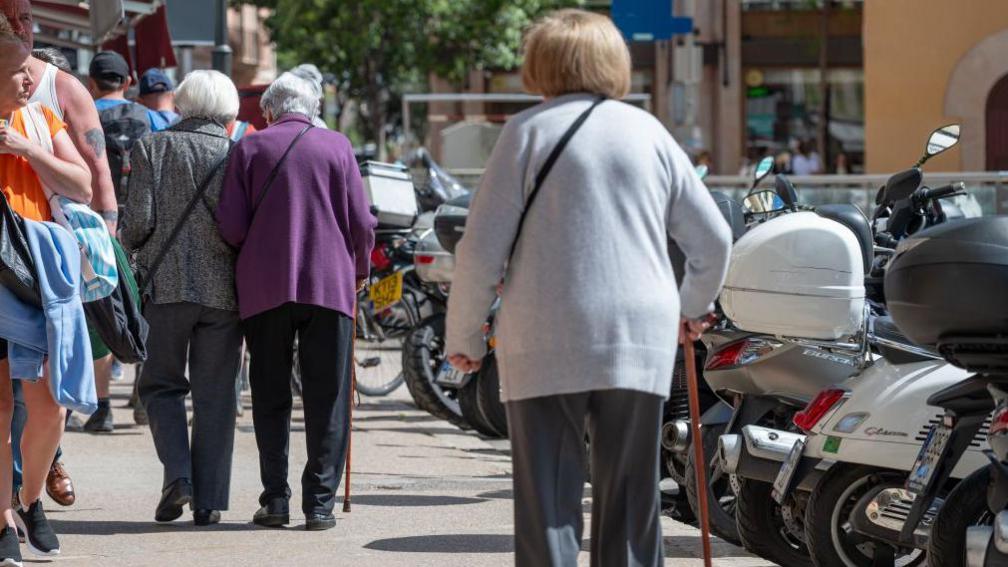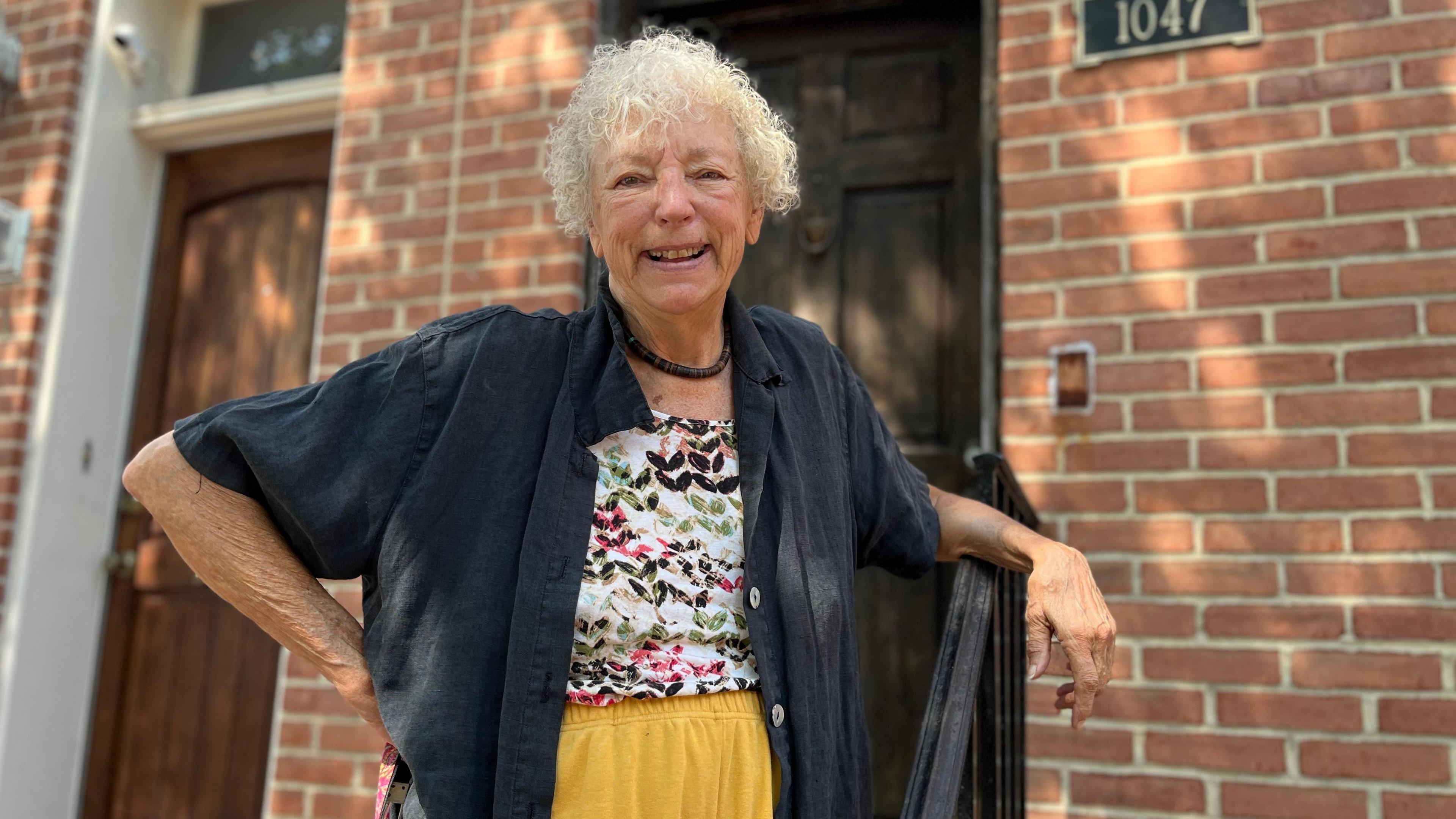Spain looks to immigrants to drive economy

Asylum seekers such as these can find work in Spain six months after they have arrived
- Published
A group of Sub-Saharan African men are playing bingo in a conference room of a hotel near the northern Spanish city of León.
They laugh and celebrate when their numbers are called out, but many of these asylum seekers have harrowing stories.
Among them is Michael, who fled Ghana to escape a violent feud that saw his sister and father killed. After travelling by land to Morocco, he paid a trafficker who put him on an inflatable boat crammed with people which took him to the Canary Islands.
“I was so happy, because I knew all my troubles, and the people trying to kill me, were behind me,” he says. “Because once you are in Spain you are safe.”
In Ghana he worked as a petrol pump attendant and a storekeeper. He also started studying human resource management, which he hopes to be able to continue in Spain once he has settled.
“Spain is one of the most respected countries in the world,” he says. “Being here is an opportunity for me.”

Migrants and refugees who try to take small boats to Spain often have to be rescued
Around 170 asylum seekers are staying in this hotel, in the town of Villaquilambre, which has been converted into a migrant centre.
They are among the many thousands of people who take the maritime route between the African coast and Spain each year.
So far this year, more than 42,000 undocumented migrants, external have arrived in Spain, an increase of 59% on 2023, the vast majority having undertaken the perilous crossing to the Canary Islands.
The archipelago’s difficulties in managing these large numbers have contributed to a fierce political debate about immigration, mirroring that in many other European countries. In Spain the controversy is driven in great part by the far-right Vox party, which frequently describes the trend as an “invasion”., external
However, the arrivals have also underlined a major potential source of manpower for an economy which faces stiff demographic challenges.
Javier Díaz-Giménez, a professor of economics at the IESE business school and an expert in pensions, says that a baby boom which lasted from the mid-50 to the late-70s has created a generation of Spaniards who are heading for pension age, and the “baby crash” that followed means there are not enough workers to replace them.
“The next 20 years are going to be critical, because more and more people are going to retire,” he says. “According to the most recent demographic scenario, 14.1 million people will retire during that time.”
One way of tackling the workforce deficit, he says, is to ape the kind of economic model implemented by Japan, which has a similarly low birth rate, by investing heavily in algorithms and machines. The obvious alternative to that is immigration.
“If you want to grow GDP, if you want to pay pensions for all the retiring baby boomers, you need to grow GDP in a different way to how we’re growing it now, because there will not be as many people, unless we bring them in through immigration,” adds Prof Díaz-Giménez.

Spain has an aging population
Spain’s central bank has put a figure on the projected labour shortfall. In a report published in April, it said that the country will need around 25 million immigrants , externalover the next 30 years.
The left-wing Spanish government has also made the economic case for immigrants, with Prime Minister Pedro Sánchez describing them as representing “wealth, development and prosperity” for his country, while on a recent tour of Mauritania, Gambia and Senegal.
“The contribution of migrant workers to our economy is fundamental, as is the sustainability of our social security system and pensions,” he said.
Mr Sánchez’s coalition is hoping that a proposal to legalise the status of up to 500,000 undocumented migrants, mainly from Latin America, will get through parliament. Spain has seen nine such mass regularisations in its democratic era, most recently in 2005 under a previous government led by the Spanish Socialist Workers' Party.
However, the country’s economic needs contrast with ordinary Spaniards’ perception of immigration. A new poll shows that 41% of people are “very worried", external by the phenomenon, making it their fifth-biggest concern after inflation, housing, inequality and unemployment.
While only 9% of Spaniards associate immigrants with economic progress, 30% link them to insecurity, and 57% believe that there are too many of them.
Villaquilambre, meanwhile, is an example of how undocumented new arrivals can integrate into the workforce.
The asylum seekers here are allowed to work six months after their arrival in Spain.
“Before they receive the authorisation to start working we place great emphasis on them learning Spanish, as well as offering them training courses and classes on risk avoidance,” says Dolores Queiro, of the San Juan de Dios Foundation, the non-governmental organisation that manages the migrant centre in Villaquilambre.
“When the date for them being able to start working approaches we get in touch with different companies – and they contact us as well – and we start looking for jobs for them."
Companies get in touch, she says, “because they know that we have people here who want to work.”

Makan, from Mali, now works for a local Spanish business
Makan, from Mali, has just started working for a local business, GraMaLeon, which makes walls, bathrooms and kitchen counters out of marble and granite. He commutes the short distance from the hotel to the factory each day on an electric scooter.
“I’m happy to be working,” he says, in halting Spanish, after completing a shift hauling slabs of marble around the factory.
Ramiro Rodríguez Alaez, co-owner of the business, which employs around 20 people, says that finding workers is not easy.
“We need a lot of manpower in this profession. But it’s tough, it gets cold, you have to lift heavy weight, so it’s not a job that many young people here want to do.
“There aren’t a lot of companies in this industry around here, but those that do exist all need people. We’re all looking for people locally and we can’t find them.”
He adds: “Immigrants provide an important source of manpower for us.”
Related topics
Read more global business and tech stories
- Published7 October 2024

- Published3 October 2024

- Published30 September 2024

- Published19 September 2024
